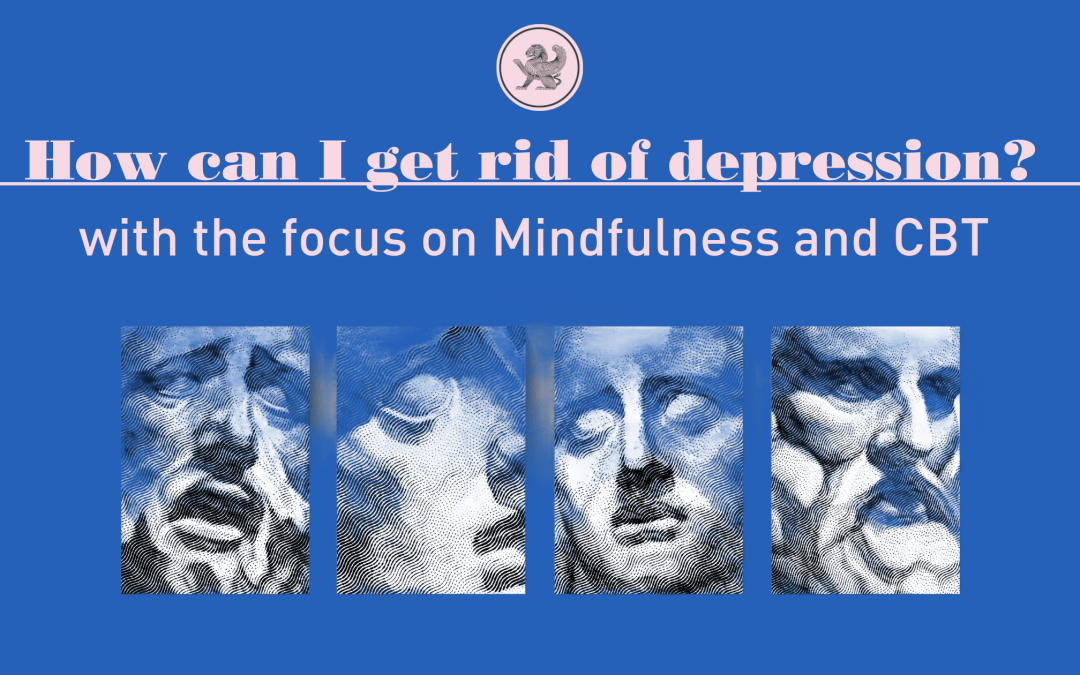Firstly, we will look at the most important actions you can take to get rid of depression. Then I will discuss one of my favourite topics, mindfulness, and how practicing mindfulness can help treat depression.
1. Psychotherapy: Engaging in talk therapy, such as cognitive-behavioural therapy (CBT), interpersonal therapy (IPT), or psychodynamic therapy, can help patients identify and change unhelpful thought patterns and behaviours, improve communication skills, and develop healthy coping strategies.
2. Medication: Antidepressant medications, such as selective serotonin reuptake inhibitors (SSRIs), serotonin-norepinephrine reuptake inhibitors (SNRIs), or other classes of drugs, can help regulate mood and alleviate symptoms of depression. Working closely with a healthcare professional is crucial to find the most appropriate medication and dosage for each individual.
3. Mindfulness-based interventions: Practices like mindfulness-based cognitive therapy (MBCT) or mindfulness-based stress reduction (MBSR) can help patients develop greater self-awareness, self-compassion, and coping skills to manage depressive symptoms better.
4. Lifestyle changes: Incorporating regular physical activity, maintaining a healthy diet, getting sufficient sleep, and reducing alcohol and drug use can have a positive impact on mental health and well-being.
5. Social support: Building and maintaining strong connections with friends, family, or support groups can provide emotional support, encouragement, and a sense of belonging, which can be invaluable in overcoming depression.
6. Stress management: Developing healthy strategies to manage stress, such as relaxation techniques, deep breathing exercises, or engaging in enjoyable hobbies, can help mitigate the impact of stress on depressive symptoms.
7. Professional help: In some cases, patients may benefit from working with other healthcare professionals, such as psychologists, counsellors, or social workers, who can provide additional support and guidance in addressing the underlying factors contributing to depression.
It’s important to remember that the path to recovery from depression can differ for each person, and what works for one individual may not be as effective for another. Working closely with a mental health professional, such as a psychiatrist or psychologist, can help patients develop a personalized treatment plan that addresses their specific needs and supports their journey towards mental well-being.
How does CBT incorporate mindfulness?
Cognitive Behavioural Therapy (CBT) and mindfulness are two distinct therapeutic approaches, but they can be integrated to enhance the overall effectiveness of treatment. CBT is a structured therapy that focuses on identifying and changing unhelpful thought patterns and behaviours, while mindfulness emphasizes non-judgmental awareness of the present moment. By incorporating mindfulness into CBT, therapists can help clients cultivate a more balanced and adaptive way of relating to their thoughts and emotions.
How does mindfulness fit into the CBT approach of an MBCT program?
1. Developing self-awareness: Mindfulness encourages individuals to pay attention to their thoughts, emotions, and bodily sensations with an attitude of curiosity and acceptance. By incorporating mindfulness into CBT, clients can develop greater self-awareness, making identifying problematic thought patterns and emotional reactions easier.
2. Enhancing cognitive defusion: Cognitive defusion is a technique that helps individuals recognize that their thoughts are merely mental events and not facts. Mindfulness can help clients observe their thoughts without becoming entangled in them, which supports the process of cognitive defusion in CBT.
3. Emotional regulation: Mindfulness encourages individuals to accept their emotions without judgment and resist the urge to suppress or react impulsively to them. By integrating mindfulness into CBT, clients can learn to respond more skillfully to their emotions, leading to better emotional regulation.
4. Mindful behavioural experiments: In CBT, clients are often encouraged to engage in behavioural experiments to test their beliefs and assumptions. By approaching these experiments with a mindful attitude, clients can develop a more flexible and adaptive perspective on their experiences and outcomes.
5. Mindful exposure: CBT often involves exposure therapy, where clients gradually face feared situations to reduce anxiety and avoidance behaviours. Incorporating mindfulness during exposure can help clients remain present, open, and accepting of their experiences, leading to more effective anxiety reduction.
6. Mindful self-compassion: CBT can integrate mindfulness to promote self-compassion, helping clients develop a more supportive attitude toward themselves. This can be particularly beneficial in addressing self-critical thoughts and negative self-beliefs.
In summary, incorporating mindfulness into CBT can help clients develop a more balanced and adaptive relationship with their thoughts and emotions, enhancing therapeutic outcomes. While some CBT practitioners may already integrate mindfulness techniques into their practice, specific therapy approaches like Mindfulness-Based Cognitive Therapy (MBCT) explicitly combine these two therapeutic modalities.
Interested in MBCT? Click here to view more.

